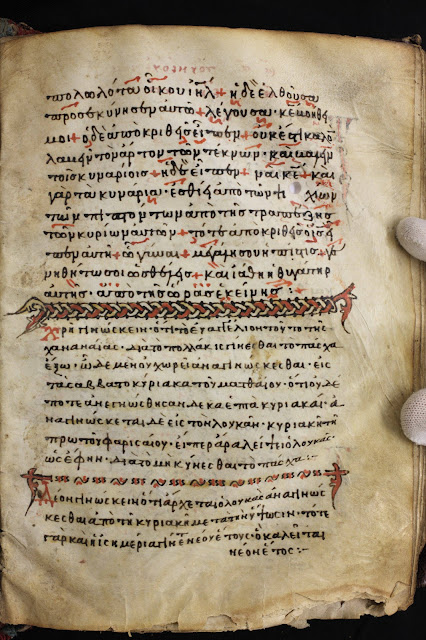Explore medieval manuscripts on Kura Heritage Collections Online
One of the inspirations for our current heritage exhibition Miraculous: medieval manuscripts was being able to view our entire medieval manuscripts collection on Kura Heritage Collections Online. Over half of these remarkable books are fully digitised and can be browsed and enjoyed from any device or location.
Explore more from the books that feature in the Miraculous exhibition below, or dive into the full collection of medieval manuscripts here.
Rossdhu Book of Hours
Medieval manuscripts are often described as “illuminated”, meaning embellished with gold, silver and luminous colours. These illuminations are found in the initial letters of words, and in borders and pictures.As well as being decorative and a pleasure to look at, initials and borders help the reader to find the way through a book of tightly written text with no page numbers or punctuation. They play the role of headings and punctuation by marking the start of a new section and indicating paragraphs, verses, or corrections.
 |
| Image: Page with an initial containing a scene of the Virgin Mary with the body of Christ. From: Rossdhu Book of Hours. Between 1450-1475. Auckland Libraries Heritage Collections, MedMS-G146. |
 |
| Image: St. George. From: Rossdhu Book of Hours. Between 1450-1475. Auckland Libraries Heritage Collections, MedMS-G146. |
The Rossdhu Book of Hours is written in 'gothic' script, the predominant form of handwriting in Germany, England and France from the 12th century to about 1500. In gothic handwriting letters are angular, and verticals, straight lines and diagonals are emphasised. It was used particularly for formal religious works.
Browse the Rossdhu Book of Hours on Kura Heritage Collections Online
Gospel lectionary
The text in the Gospel lectionary is an example of a different type of handwriting. This book contains readings from the Gospels written in dark brown ink in a regular Greek cursive script called 'Greek minuscule'.
 |
| Image: Gospel Lectionary. 12th century. Auckland Libraries Heritage Collections, MedMS-G123. |
The writing in the book is decorated with 163 initials drawn in ink, and some pages include interlaced 'ropework' headpieces infilled with red and yellow that mark important divisions in the text.
 |
| Image: Page showing interlaced ropework headpieces. From: Gospel lectionary. 12th century. Auckland Libraries Heritage Collections, MedMS-G123. |
Browse the Gospel lectionary on Kura Heritage Collections Online
Gospel-Book
 |
| Image: Canon table. From: Gospel-book. 12th century. Auckland Libraries Heritage Collections, MedMS-G124. |
 |
| Image: Page showing decorative headpiece introducing the Gospels. From: Gospel-book. 12th century. Auckland Libraries Heritage Collections, MedMS-G124. |
An interlaced tailpiece is drawn at the end of the Gospel of St. Mark.
 |
| Image: Page showing interlaced tailpiece concluding the Gospel of St. Mark. From: Gospel-book. 12th century. Auckland Libraries Heritage Collections, MedMS-G124. |
Le Livre de Boèce de consolacion (The consolation of philosophy)
 |
| Image: Page layout showing text and glosses. From: Le Livre de Boèce de consolacion. About 1425-1430. Auckland Libraries Heritage Collections, MedMS-G119. |
The book also contains decorative initials, some illuminated with gold.
 |
| Image: Page showing decorated initials. From: Le Livre de Boèce de consolacion. About 1425-1430. Auckland Libraries Heritage Collections, MedMS-G119. |
Larger initials introduce the prologue and each of the five books that make up the Consolation.
 |
| Image: Page showing large decorated initial. From: Le Livre de Boèce de consolacion. About 1425-1430. Auckland Libraries Heritage Collections, MedMS-G119. |
Metaphysica, Physica, De Meteoris (Metaphysics, Physics, Meteorology)
This translation of Aristotle by William of Moerbecke looks like it's been studied closely, with extensive comments added in the margins by several hands over two centuries.
 |
| Image: Page showing glosses and marginal notes. From: Metaphysica, Physica, De Meteoris. Late 13th century. Auckland Libraries Heritage Collections, MedMS-G126. |
Browse Metaphysica, Physica, De Meteoris on Kura Heritage Collections Online
De bello Judaico (The Jewish war)
Italian humanists of the early Renaissance took inspiration from the rediscovery of ancient manuscripts by classical writers. They particularly admired the handwriting and decoration in them, and used the script as the basis for a clear, rounded, neat handwriting. Great attention was paid to the elegant proportions of page layout, and to the quality of vellum used. The text was written in a single column, a style which continues in book production to this day.
 |
| Image: Page featuring a decorated initial. From: De bello Judaico. Between 1455-1459. Auckland Libraries Heritage Collections, MedMS-G147. |
The layout of this page from De bello Judaico is simple and spacious. The text is written in a round 'humanist' script in a single column, with the headings for each book in red. The only decoration is the burnished gold initial “C”. Around it white vinestems interlace and twist on a coloured background. This pattern was another borrowing from the older manuscripts so admired by the humanists.
Additional medieval manuscripts on display
Missale ad usum Romanum (Besancon Missal). Latin. Eastern France, between 1450 and 1500.
 |
| Image: Missale ad usum Romanum. Latin. Eastern France (Besancon), between 1450 and 1500. 305 x 225mm. De Hamel no. 18. Auckland Libraries Heritage Collections, MedMs-G138. |
Astesanus de Ast. Summa de casibus conscientiae (Cases of conscience). Latin. Flanders, between 1300 and 1325.
Antiphonary. Latin. Italy, 16th century.
 |
| Image: Antiphonary. Latin. Italy, 16th century. 351 x 245 mm. De Hamel no. 40. Auckland Libraries Heritage Collections, MedMS-S1588. |
Browse the Antiphonary on Kura Heritage Collections Online

Interesting
ReplyDelete